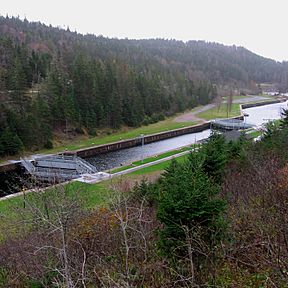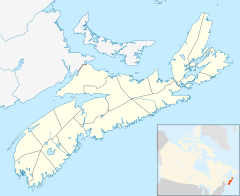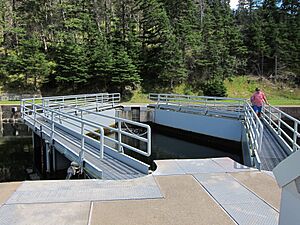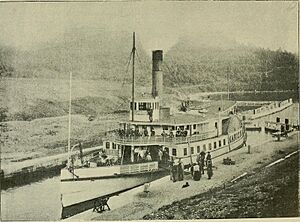St. Peters Canal facts for kids
Quick facts for kids St. Peters Canal |
|
|---|---|

The single lock in the canal features an unusual double-gate system used because each end of the canal (Atlantic Ocean and Bras d'Or Lake) has a different tidal regime.
|
|
| Country | Canada |
| Coordinates | 45°39′19.5″N 60°52′6.85″W / 45.655417°N 60.8685694°W |
| Specifications | |
| Maximum boat length | 301 ft 0 in (91.74 m) (Regularly limited to 91.44 metres (300.0 ft)) |
| Maximum boat beam | 47 ft 0 in (14.3 m) |
| Minimum boat draft | 16 feet (4.9 m) |
| Locks | 1 |
| Status | Open |
| Navigation authority | Parks Canada |
| History | |
| Construction began | 1854 |
| Date completed | 1869 |
| Geography | |
| Start point | St. Peters Inlet of Bras d'Or Lake |
| End point | St. Peters Bay of the Atlantic Ocean to the south |
The St. Peters Canal is a special waterway in eastern Canada. It is on Cape Breton Island in Nova Scotia. This canal cuts across a narrow strip of land, called an isthmus. This strip connects St. Peters Inlet of Bras d'Or Lake to the north with St. Peters Bay of the Atlantic Ocean to the south.
Contents
How Does the Lock Work?
Most canals have water flowing in one direction. This means one side is always higher than the other. But the St. Peters Canal is different. The water levels in Bras d'Or Lake and the Atlantic Ocean change at different times. Sometimes the ocean side is higher, and sometimes the lake side is higher.
Because of this, the canal needs a special "double" lock gate. A lock is like a water elevator for boats. It helps boats move between different water levels. Most locks have two gates, each with two doors that form a 'V' shape when closed.
The St. Peters Canal lock has four doors at each end. When closed, these doors form a diamond shape. No matter which side has higher water, one pair of doors will always work. This unique design is the only one of its kind in North America.
How Big Can Boats Be?
Boats using the canal must fit through the lock. The lock is about 91.44 meters (300 feet) long. It is 14.45 meters (47.4 feet) wide. Boats can be up to 4.88 meters (16 feet) deep in the water. They also need to be shorter than 32 meters (105 feet) above the water. This is called their "air draught."
A swing bridge crosses over the canal. When the bridge is closed, boats have 6 meters (20 feet) of space underneath. This bridge can swing open to let taller boats pass. It is operated from a small building on Grenville Street.
When is the Canal Open?
The St. Peters Canal is usually open for boats from May to October each year. During the busiest times, from mid-June to mid-August, it is open for longer hours. It is important for boaters to check the current schedule. Boats must arrive 30 minutes before the canal closes.
The canal grounds are open all year round. This means you can visit the area even when boats are not passing through. About 1,000 boats use the canal each year.
A Look Back: History of the Canal
Long ago, the Mi'kmaq people used to carry their canoes across this narrow strip of land. In 1650, a French fur trader named Nicholas Denys built a "haulover road" here. This was a path to pull boats across.
People started thinking about building a canal in 1825. Construction finally began in 1854. It took 15 years to build because workers had to dig through 20 meters (66 feet) of solid granite rock. The canal was finished in 1869. It is 800 meters (2,600 feet) long and about 30 meters (100 feet) wide.
The canal was very busy in the late 1800s and early 1900s. It helped ships move goods around Cape Breton Island. Over the years, the canal was made wider and deeper. After World War II, it became too small for large modern ships. Now, it is mostly used by pleasure boats.
The St. Peters Canal was named a National Historic Site of Canada in 1929. This means it is an important place in Canadian history. Parks Canada now manages and takes care of the canal.
The New Bridge
The old swing bridge over the canal was built in 1936. It was almost 80 years old and needed to be replaced. Parks Canada decided it was better to build a new bridge instead of just repairing the old one.
Work on the new bridge started in 2016. The new bridge has two lanes for cars, which is an improvement from the old one-lane bridge. It opened in mid-June 2017. An official ceremony was held in November 2017 to celebrate the new bridge. This new bridge is the fifth one to cross the canal since it first opened.




